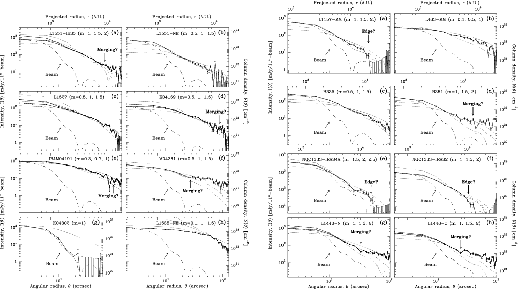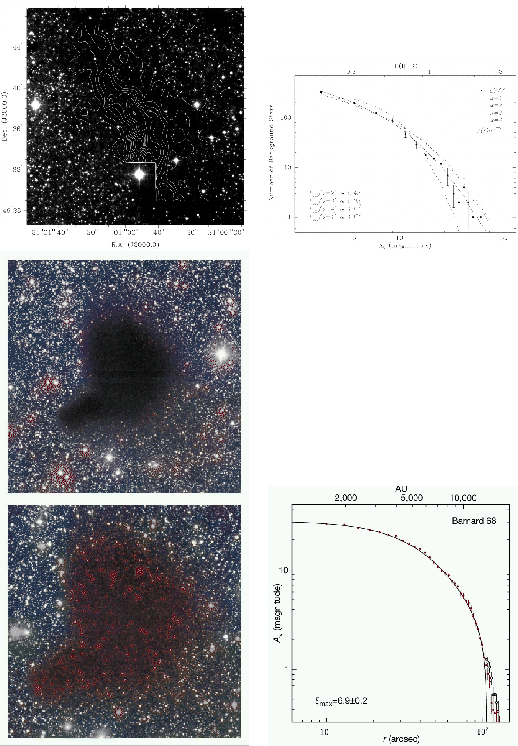



Next: Mass Spectrum
Up: Introduction
Previous: T Tauri Disks
Contents
Motte & André (2001) made  1.3 mm continuum mapping survey of the embedded young stellar
objects (YSOs) in the Taurus molecular cloud.
Their maps include several isolated Bok globules, as well as protostellar objects in the Perseus cluster.
For the protostellar envelopes mapped in Taurus, the results are roughly consistent with the
predictions of the self-similar inside-out collapse model of Shu and collaborators (section 4.5.1).
The envelopes observed in Bok globules are also qualitatively consistent with these predictions,
providing the effects of magnetic pressure are included in the model.
By contrast, the envelopes of Class 0 protostars in Perseus have finite radii
1.3 mm continuum mapping survey of the embedded young stellar
objects (YSOs) in the Taurus molecular cloud.
Their maps include several isolated Bok globules, as well as protostellar objects in the Perseus cluster.
For the protostellar envelopes mapped in Taurus, the results are roughly consistent with the
predictions of the self-similar inside-out collapse model of Shu and collaborators (section 4.5.1).
The envelopes observed in Bok globules are also qualitatively consistent with these predictions,
providing the effects of magnetic pressure are included in the model.
By contrast, the envelopes of Class 0 protostars in Perseus have finite radii
 AU and are a factor of 3 to 12 denser than is predicted by the standard model.
Another method to measure the density distribution is to use the near IR extinction.
From
AU and are a factor of 3 to 12 denser than is predicted by the standard model.
Another method to measure the density distribution is to use the near IR extinction.
From  colors of background stars, the local value of
colors of background stars, the local value of  in a dark cloud can
be obtained using a standard reddening law,
in a dark cloud can
be obtained using a standard reddening law,
 |
(1.7) |
if the intrinsic colors of background stars are known.
Here, the color excess is defined as the difference between the observed color and the intrinsic color:
 .
We can convert the extinction to the column density assuming the gas/dust ratio is constant
.
We can convert the extinction to the column density assuming the gas/dust ratio is constant
 |
(1.8) |
This is a standard method to obtain the local column density of the dark cloud using
the near IR photometry.
See Figure 1.23.
If the density distribution is expressed as
 |
(1.9) |
where  is a physical distance from the center.
The column density distribution against the projected distance of the line-of-sight from the center of the cloud is given as
is a physical distance from the center.
The column density distribution against the projected distance of the line-of-sight from the center of the cloud is given as
![\begin{displaymath}
N_\rho (p)=2\int_0^{(R^2-p^2)^{1/2}}\rho\left[(s^2+p^2)^{1/2}\right]ds,
\end{displaymath}](img222.png) |
(1.10) |
where  represents the outer radius of the cloud.
Using equation (1.8), this yields
represents the outer radius of the cloud.
Using equation (1.8), this yields  distribution
distribution
 |
(1.11) |
If background stars are uniformly distributed,
the number of stars with
 is proportional to the area which satisfies
is proportional to the area which satisfies
 .
That is, if we plot
.
That is, if we plot  against
against  , this gives the number distribution of background
stars with
, this gives the number distribution of background
stars with  .
Figure 1.25 shows the result of L977 dark cloud by Alves et al (1998).
Recently, Alves et al (2001) derived directly the radial distribution of
.
Figure 1.25 shows the result of L977 dark cloud by Alves et al (1998).
Recently, Alves et al (2001) derived directly the radial distribution of  by comparing
the
by comparing
the  model distribution for B68.
They obtained a distribution is well fitted by the Bonner-Ebert sphere in which
a hydrostatic balance between the self-gravity and the pressure force is achieved (lower panels
of Fig.1.25) (see section 4.1.1).
model distribution for B68.
They obtained a distribution is well fitted by the Bonner-Ebert sphere in which
a hydrostatic balance between the self-gravity and the pressure force is achieved (lower panels
of Fig.1.25) (see section 4.1.1).
Figure 1.23:
Schematic view to explain an  distribution.
distribution.
 |
Figure 1.24:
(Left:) Radial intensity profiles of the environment of 7 embedded
YSOs (a-g) and 1 starless core (h).
(Right:) Same as left panel but for 4 isolated globules (a-d) and 4 Perseus protostars (e-h).
Taken from Motte & Andre (2001).
 |
Figure 1.25:
Density distribution of L977 (top) and B68 (bottom) dark clouds.
(Top-left:) L977 dark cloud dust extinction map derived from the infrared (H-K) observations.
(Top-right:) Observed frequency distribution of extinction measurements for L977
and the predictions from clouds models with density structures
 having
having  (dashed line), 2 (solid line), 3 (dotted line), and 4 (dash-dotted line).
(Bottom-left:) B68 images (false color images made from B, V, and I images (top),
and B, I, and K images (bottom)).
(Bottom-right:) Spatial distribution of the column density.
(dashed line), 2 (solid line), 3 (dotted line), and 4 (dash-dotted line).
(Bottom-left:) B68 images (false color images made from B, V, and I images (top),
and B, I, and K images (bottom)).
(Bottom-right:) Spatial distribution of the column density.
 |
In this fields, we should pay attention to the density distribution in cylindrical clouds.
As seen in the Taurus molecular cloud, there are may filamentary structures in a molecular cloud.
In  4.1, we will give
the distribution for a hydrostatic spherically symmetric and that of a cylindrical cloud.
The former is proportional to
4.1, we will give
the distribution for a hydrostatic spherically symmetric and that of a cylindrical cloud.
The former is proportional to
 and the latter is
and the latter is
 .
Therefore, the distribution
.
Therefore, the distribution
 was expected for cylindrical cloud.
From near IR extinctions observation (Alves et al 1998), even if a cloud is rather elongated
[Fig.1.25 (top-left)], the power of the density distribution is equal
to not -4 but
was expected for cylindrical cloud.
From near IR extinctions observation (Alves et al 1998), even if a cloud is rather elongated
[Fig.1.25 (top-left)], the power of the density distribution is equal
to not -4 but  .
Fiege, & Pudritz (2001) proposed an idea that a toroidal component of the magnetic field,
.
Fiege, & Pudritz (2001) proposed an idea that a toroidal component of the magnetic field,  ,
plays an important role in the hydrostatic balance of the cylindrical cloud (Fig.1.26).
,
plays an important role in the hydrostatic balance of the cylindrical cloud (Fig.1.26).
Figure 1.26:
A structure of magnetic fields in the L1641 region.
Polarization of light from embedded stars (Vrba et al. 1988) is shown by a bar.
The direction of magnetic fields in the line-of-sight is observed using the HI Zeeman splitting, which
is shown by a circle and cross (Heiles 1989).
 |




Next: Mass Spectrum
Up: Introduction
Previous: T Tauri Disks
Contents
Kohji Tomisaka
2007-07-08


